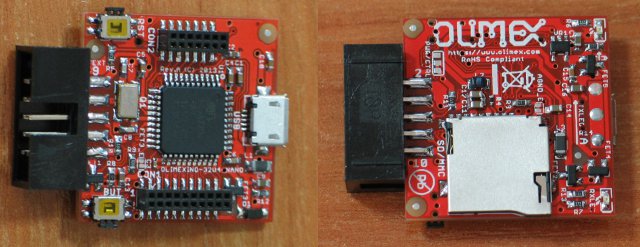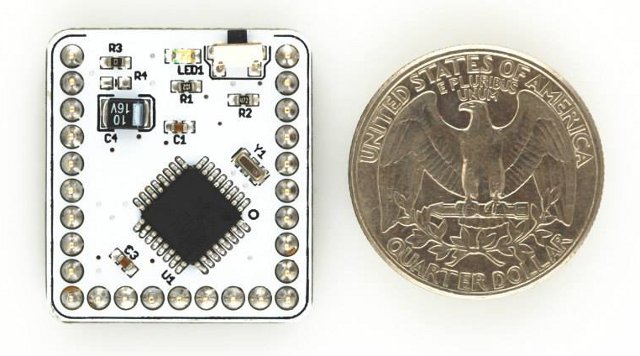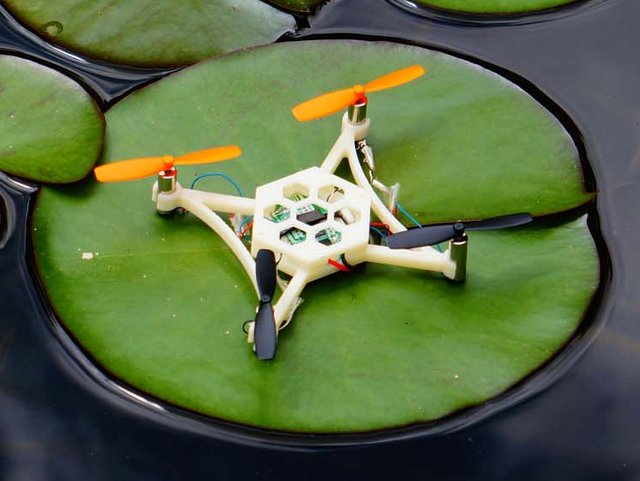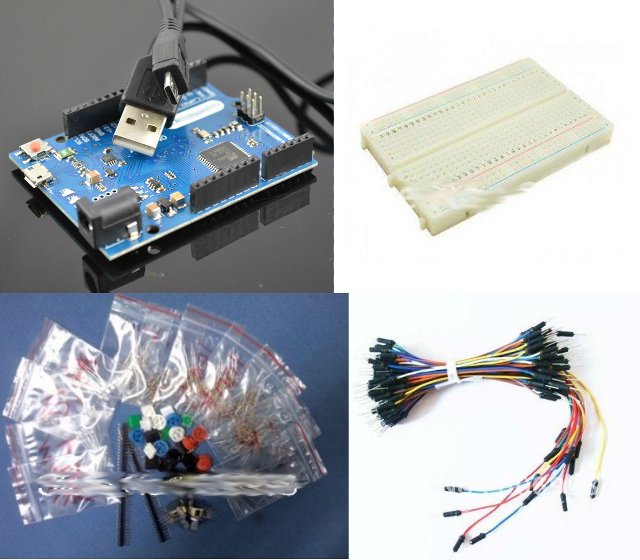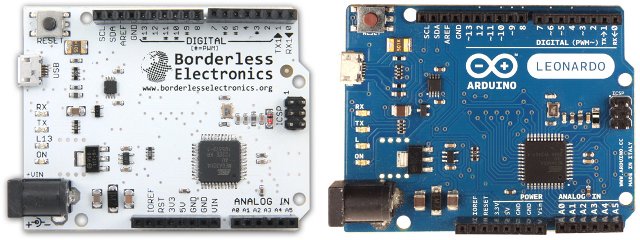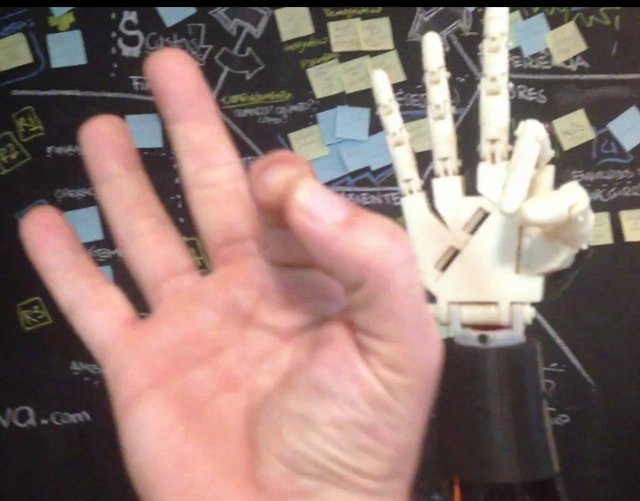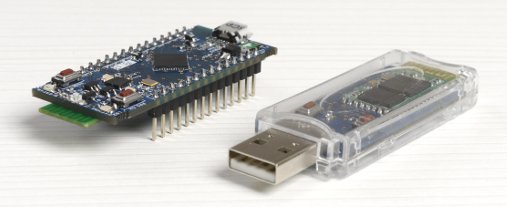Last month, I wrote about Microduino, a tiny Arduino compatible board about the size of a coin. Olimex has also being working on their own tiny version of the Arduino board, OLIMEXINO-NANO, slightly larger than Microduino (30x30mm vs 25.4×27.94mm) but also featuring the UEXT connector which is an advantage if your own or plan to use UEXT expansion boards, but it could be an inconvenience if you don’t, as the connector is a little bulky. Here are the specs of the board: MCU – Atmel ATMega32U4 processor (Leonardo compatible) with 2.5KB RAM, 32KB flash memory, and 1KB EEPROM. Storage (external) – microSD card connector for data logging on SD-card USB – micro USB connector for programming and power supply when debugging Misc – RESET button, USER button, 2x status LEDs Expansion Connectors: UEXT connector for RF, Zigbee, Ethernet, RELAY, RGB LED, etc UEXT modules Connector 14 pin 0.05″ Connector 20 […]
Microduino Is a Tiny Arduino Compatible Board with Stackable Shields
Microduino is a small board based on Atmel AVR or ATMega MCU which is software compatible with Arduino boards. The core board features the Atmel MCU, and Microduino shields can be stacked on the core board to add functionalities. There are actually 2 core boards: Microduino core and Microduino core+ with more performance. They share the following specifications: MCU: Core – Atmel ATmega328P or ATmega168PA, equivalent to Arduino UNO Core+ – Atmel ATmega644PA or ATmega1284P, with performance matching that of the Arduino Mega2560. System Memory – 1K to 16K SRAM on-chip Storage – 16K to 128K flash + 512 bytes to 4KB EEPROM on-chip Operating Voltage: 5V/3.3V Input Voltage (limits): 6-20V Digital I/O Pins: 14, including 6 capable of PMW output, plus serial, SPI, TWI, Analog Input Pins: 8 (2 more compared to Arduino Uno) DC Current per I/O Pin: 40 mA DC Current: 50 mA Dimensions – 25.40mm X […]
$49 (and up) Hex is an Arduino-compatible, Soon-to-be Open Source Nanocopter Kit
Do you remember Mecam, an upcoming $49 nanocopter with a camera? AFAIK, it’s not there yet, but a similar product with a similar price point is now “available” on Kickstarter. Hex nanocopters (quadcopter and hexacopter versions) are not voice-controlled, and do not come with a camera by default, but you can control them with iOS or Android mobile devices, and a camera can be fitted if needed. It comes as a kit, so you’ll have to assemble it yourself, and since it’s fully open source, you could even customize it to your taste. Hex specifications: Propellers – Size: 56×8.5 mm, Fits shaft: 1.0 mm Motors – Diameter: 7.0 mm, Length: 20 mm, Shaft diameter: 1.0 mm, Over 50,000 rotations per minute (rpm) Flight Control System: Flight control – Microwii Copter Processor – Atmel ATMega32u4 Gyro and Accel – InvenSense MPU6050 (6-axis) Battery – 350mAh battery (Flight Time – 7 minutes) […]
How to Buy an Arduino Leonardo (Clone) Kit for Less than $20
Borderless Electronics Indiegogo campaign for their $9 electronics kit with an Arduino Leonardo clone went so well that the owner of the campaign decided to limit the total number of boards to 15,000, and basically stop the campaign early to avoid production delays. For $12 ($9 + shipping), you could get a full kit with: Arduino Leonardo clone A mini breadboard with 10 Jumper wires A plug for a 9V battery A few components: 6 LEDs, 10x 330 Ohm resistors, 10x 1 KOhm resistors, 3x push buttons, 2 NPN transistors, 5 diodes, a light sensor, and a sound buzzer A micro USB to USB cable Although they may start a new one campaign in a few months, the campaign is over, and you can’t get this cheap Arduino kit anymore. But one of my reader (onebir) let me know that for less than $20, you can get an Arduino Leonardo […]
Borderless Electronics Sells $9 Arduino Compatible Starter Kit
The Raspberry Pi fundation, a nonprofit organization, has brought a low cost ARM Linux platform to the masses, and Arduino already did that with electronics, but Harold Timmis, an engineer, found out it was still not cheap enough as he worked as a volunteer teaching electronics at his library. So he (and others) decided to clone Arduino Leonardo, setup a website called Borderless Electronics, and sell it without profit via Indiegogo for just $9 ($12 including shipping). The board is indeed the same as Arduino Leonardo with different color, logo, and name: Microcontroller – Atmel ATmega32u4 @ 16 MHz SRAM – 2.5 KB onchip (ATmega32u4) Flash Memory – 32 KB onchip (ATmega32u4) of which 4 KB used by bootloader EEPROM – 1 KB onchip (ATmega32u4) Operating Voltage – 5V Input Voltage – (recommended) 7-12V | (limits) 6-20V Digital I/O – 20 pins PWM – 7 channels Analog Input – 12 […]
Open Source Prosthetic Arm Controlled By Muscle Movements
Gustavo Brancante is working on a very interesting project that let you control a prosthetic arm with your muscle movement using open source technology with InMoov Hand (which can be 3D printed), Arduino Uno R3, and Olimex Electrocardiography electromiography shield (SHIELD-EKG-EMG). This is called a Myo-Electric Prosthesis. Gabriel wrote a tutorial to use his “open arm” which I’ll summarize here. On the hardware front, you’ll also need a UDP compatible Wifi Shield configured as a UDP server with a fixed IP in the same LAN as the smartphone, and 57600 bps. TouchOSC (for smartphone and Workstation) is used with the following layout for calibration and feature selection. Finally load the program below to your Arduino board: Once everything is connected together, you should be able to do that: The demo looks impressive, but this is still work in progress, and next step will be to use a four channel EMG instead […]
$25 Babuino Stick & Board Let You Control Your Devices with Your Smartphone and Vice Versa
Babuino Stick and Babuino Board are tiny low cost Arduino-compatible USB dongle and board featuring Atmel AVR MCU, and Bluetooth 2.0 + EDR connectivity. Both have basically the same hardware, but Babuino Stick is more suited to control a computer or Smart TV via your smartphone, and Babuino Board can be used for robotics and automation projects. The device can also be used to control your smartphone (e.g. to write SMS) from your PC or Mac. Here are the specifications of these “Babuini”: MCU – Atmel ATXMega128A1 @ 32 MHz with 128KB flash program memory, 8KB boot code section, and 8KB SRAM. Master/Slave selectable Bluetooth 2.0 + EDR module Infrared transmitter and receiver USB – micro USB (board) and USB port (stick) User and reset push-buttons Headers (Board only) – ICSP pins, ADC & DAC, PWM, I2C & SMBus, SPI and UART LEDs – Bluetooth and User LED for both, […]
Souliss Automation and IoT Framework Makes Your Home Smarter
Souliss is an open-source framework written in C/C++ for the Internet of Things and home automation that runs on Arduino boards, or other Atmel AVR MCU based boards, and let your control lighting, heating, or anything else you can think of via your Android device, or switches connected to your board(s). You can get started with Souliss in 3 steps: Getting the building blocks, for example: Arduino, Olimex, or other AVR boards (See list of supported boards) Relay boards ON/OFF Switches, Lights, etc… Wi-Fi router Download and load Souliss to an AVR powered board controlling real things such as lights. Monitor and/or control via Souliss Home Automation App for Android. A detailed getting started guide is provided on Souliss Google Code page. Internally, the framework is composed of three parts: Souliss, an application level layer, MaCaco, a communication protocol and vNet, a transport layer. I’ll skip details in this post, […]


